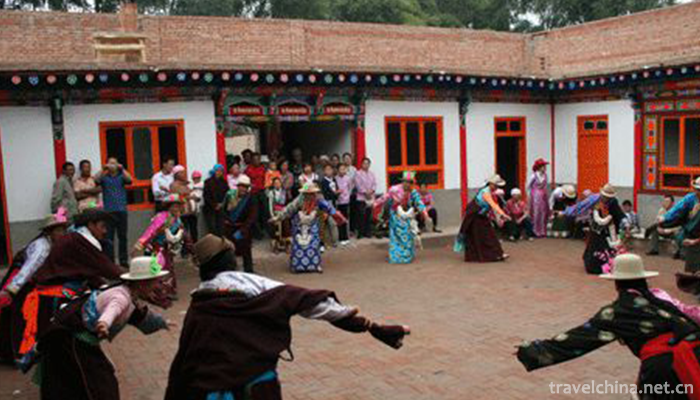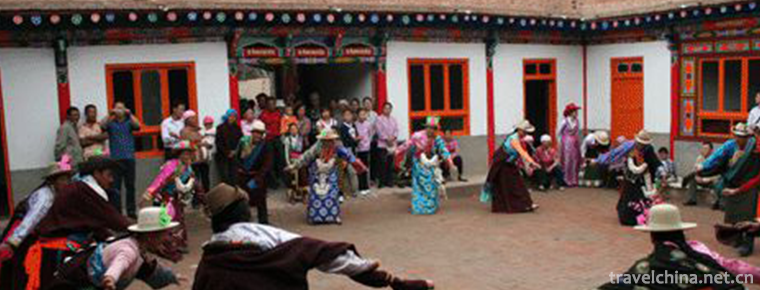Zerou
Zerou
Zerou (Shangyu Zerou), also known as Ashze, is a Tibetan folk dance in Guide County, Qinghai Province. Especially "Shangyu (Chinese: lower row) is soft" is the most important. They often perform at wedding, reception and other festive banquets.
On June 7, 2008, "Zerou" declared by Guide County of Qinghai Province was listed in the second batch of national intangible cultural heritage list with the approval of the State Council. Heritage serial number: 690 III-93.
historical origin
Overview
"Zerou" means play. Most of them perform at wedding, welcoming guests, birthday celebrations and other festive banquets. Zerou, who has been singing for more than 400 years in the locality, praises the infinite respect for his hometown and natural scenery in the way of singing and dancing. Because Asher has extensive mass participation and social foundation, his singing is inclusive in the course of hundreds of years'evolution. His tunes have developed from several initial tunes to more than 20 kinds. The structure and performance of his works have become more and more mature and become the classic of Asher's singing.
Origin and Evolution
Shang Youzerou, according to the investigation (according to the old artist Xiangxiu and Jiancuo), has a history of more than 400 years. It dances and sings, and its movements range from simple to complex. Since the beginning of several dances, it has developed to more than 20 kinds. Thirteen of them are relatively old. They are distributed in some Tibetan villages in Guide area. Shangyou is rich in content and variety, rich in lyrics and songs, simple and graceful movements, the original ecological potential remains intact, in Zerouli is more typical. Literary and artistic workers at home and abroad came to study and excavate one after another.
After the founding of the People's Republic of China, the people's government attached great importance to and supported it. Since the 1950s, Guide Shangyou has often performed in counties, prefectures and provinces. Especially since 1990, he has participated in many large-scale celebrations and square performances in Hainan. There are more than 80 performers in the cast. Shang Youzeru also performed in the large-scale Tibetan calendar celebrations held in the province.
Development characteristics
Songs are used to convey the message and assist in analogous movements.
According to historical records, Zerou originated in Xikang Aba area of Sichuan Province, and spread to Xiabai village of Guide in the mid-Ming Dynasty, and was gradually developed and promoted. It dances and sings, and its movements range from simple to complex. From only a few dances, to more than 20 kinds, of which 13 are relatively old. They are distributed in the Tibetan villages of Huangnan, Haibei, Hainan and Guide. The lower rank of Guide is more abundant in content, variety, changeable in lyrics and songs, more complex and graceful in action, and the original ecological potential remains intact, which is typical in "Zerou".
In Chinese, Shangyou means "lower row", referring to the lower row village of Hexi Town, Guide County, while gently means "play". Shangyou Zerou is a collective recreational activity. On New Year's Day, Tibetan girls wear their heads (when they are twelve, three or fifteen years old, they hold adult ceremonies for girls) and dance at wedding ceremonies. Most of the performances are performed in pairs of men and women, less than 2 people, up to 12 people, from both sides, or interlude, or dance, or line up in a circle, the scene changes at any time, rough and skilled movements, vivid and delicate metaphors, unrestrained expressions, warm atmosphere, giving the audience a feeling of comfort and happiness.
Zerou has a wide range of popularity and social foundation, unique style, rich performance, its variety, repertoire storage is large, ranking first in Tibetan dance, in Tibetan dance art has a wide range of representative and significant typicality. The ancient and profound connotation of Zeru embodies important academic value in anthropology, ethnology and folklore. At the same time, it has become a spiritual power with strong cohesion and motivation, and plays a unique role in the construction of modern spiritual civilization.
artistic characteristics
basic content
1. To eulogize justice softly, to eulogize the happy working scenes of the Tibetan people and the national customs of singing and dancing. He also praised the fattening harvest of cattle and sheep in the pastoral areas, whipping evil.
2. Zerou usually sings at festivals, Tibetan girls wearing their heads (when they are eleven, thirteen or fifteen years old) and Tibetan wedding ceremonies.
3. When performing, there are fewer than two couples of men and women, up to hundreds of people. They appear on both sides, or interlude, or dance, or line up in a circle. The scenes change at any time. The metaphor is vivid and delicate, the melody is beautiful and the atmosphere is warm, which gives the audience a feeling of comfort and happiness.
Main features
1. The combination of rituality, performance and self-entertainment has attracted the participation and attention of all walks of life. It has a broad public and social foundation and has reached a higher level in content and art.
2. It plays an important role in the minds of the Tibetan people. It is the symbol of spirit and dignity as well as the carrier of personality and emotion.
3. Shangyou Zerou is a collective recreational activity, which is inherited by the mass way. The best performances are lead dancers, lead dancers, old dancers lead new dancers, and so on, and get a wide range of dissemination.
4. Shangyou Zeru's performance can be divided into two kinds: solemnity and arbitrariness. The solemnity has a fixed time and place. The arbitrariness can be performed and jumped at any time regardless of time and place.
5. Shangyou Zerou is an art combining sound, dance and words, performing in the form of singing and dancing. Language is gorgeous, quintessential and full of literary color.
Shangyou Zerou's dance movements are vivid and delicate, and the original ecological situation remains intact. It has distinct characteristics and wide representativeness in Tibetan dance.
Inheritance and Protection
Inheritance value
1. Shangyou Zerou has distinct characteristics and diversified varieties. Shangyou Zerou has a wide range of representativeness and remarkable typicality in Tibetan dance, and has special value in understanding and promoting Tibetan dance culture.
2. Shangyou Zerou is the most representative dance of pastoral style. It is the manifestation of Tibetan people's profound thoughts and bold personality. It is well-known both inside and outside the province for its rich performance, unique style and exquisite skills. Therefore, it has unique value in researching and promoting Zerou culture and art of Tibetan nationality.
3. As Shangyou Zeru has a long history, Shangyou Zeru contains many ancient cultural information. Because of the development process of the ancient Tibetan people carried by Shangyou Zeru, Shangyou Zeru has important value in anthropology, ethnology, folklore and other research.
4. Shangyou's soft position is sacred and has wide influence. It has become a spiritual motive force with strong cohesion and motivation. Therefore, it can become a brand in the construction of modern spiritual civilization and play a unique role.
Repertoire
1. Deer Dance
2. Ajoma
3. Milk-promoting music
4. Anzhao
Inheritance pedigree
1. Heritage inheritance: old artist Lane Show (deceased), Huajia (deceased), Jigao, Pengmaozhuma, Ramao.
2. Entertainment inheritance: In wedding and festival performances, old artists teach young people.
3. Training and inheritance: Shangyou Zeru Performance Team was set up in Xiabai Village in the early liberation period, relying on the performance team for training and inheritance. Celebrations, competitions, and training of literary and artistic performances. Later, the ethnic school hired Shangyou as a soft artist, and carried on Shangyou as a soft inheritance in the school.
Current situation of inheritance
Facing the strong impact of modern culture, Rou is facing a severe crisis of survival, which can be seen as follows:
1. Well-known artists and important dance backbone have died one after another, some of them are old and frail, while the growth of new backbone forces is slow, creating a very fragile cultural environment for new well-known artists, and the phenomenon of artists and important backbone fault is emerging.
2. Because of the artists'fault and the loss of original ecological art concept, Shangyou Zeru's artistic style has become more and more distorted, resulting in the loss of original style, original characteristics and original cultural artistic conception.
3. As people become more and more indifferent to the vividness of Shangyou Zeru, from the original public participation to a few people's simple performances, Shangyou Zeru's cultural space becomes narrower and narrower, so that it eventually enters an endangered situation.


-
1.Crab Dumplings in Soup
Crab yellow soup bag is a traditional snack in Jiangsu Province. The crab yellow soup bag is made of crab yellow and crab meat with stuffing
Time 2018-10-27 -
2.Jinggangshan MountainMt Jinggang
Jinggangshan, National AAAAA Tourist Scenic Spot, National Key Scenic Spot, National Nature Reserve, Chinese Cultural Scenic Spot
Time 2018-12-08 -
3.Huizhou West Lake Scenic Spot
Huizhou West Lake scenic area is located in the central area of Huicheng in Guangdong Province, Southeast of Huizhou City, consisting of West Lake and the Red Lake, a total area of 20.91 square kilome
Time 2018-12-12 -
4.Shanghai Park Hyatt Hotel
Shanghai Park Hyatt Hotel is an exquisite modern Chinese-style residential hotel, located on the 79th to 93rd floors of Shanghai Global Financial Center, known as the Vertical Comprehensive Urban Area
Time 2018-12-16 -
5.Lingyun Mountain Scenic Area
Lingyun Mountain Scenic Spot is located in Gaoping District of Nanchong City, with an area of 20 square kilometers and a total investment of 300 million yuan. The scenic spot is dominated by Lingyun M
Time 2018-12-26 -
6.Qinghai Provincial Museum
Qinghai Museum is located in the east of Xining Square in the west of Xining City. It is the first large-scale comprehensive museum with modern functions in Qinghai
Time 2019-02-07 -
7.Saint Sophia Cathedral in Harbin
St. Sophia Church is located in Sophia Square, Daoli District, Harbin City, Heilongjiang Province, China. It is a Byzantine-style Orthodox Church built in 1907
Time 2019-02-08 -
8.Eight treasures whole chicken
It's a delicious dish with the characteristics of beige color, delicious taste and delicacy. The main raw materials used are 1 bamboo shoot hen (about 1.75 kg), 100 grams of Jiangmi, 25 grams of dates
Time 2019-03-26 -
9.The Making Skills of Hui Ink
Hui ink production technology, Jixi County, Shexian County, Huangshan Tunxi District, Anhui Province, local traditional handicraft, one of the national intangible cultural heritage.
Time 2019-05-04 -
10.Sigangli
Lincang City is located in the southwest of Yunnan Province, which is adjacent to the west, southwest of Yunnan and Myanmar. It has jurisdiction over one district, four counties and three autonomous c
Time 2019-06-16 -
11.Southwest Medical University
Southwest Medical University is an ordinary university in Sichuan Province. It is located in Luzhou, a famous historical and cultural city and a civilized city in the region of Sichuan, Yunnan, Guizho
Time 2019-08-31 -
12.Beijing University of Chinese Medicine
Beijing University of Traditional Chinese Medicine is a national key university with traditional Chinese medicine as its main subject. It is directly under the management of the Ministry of Education.
Time 2019-09-22